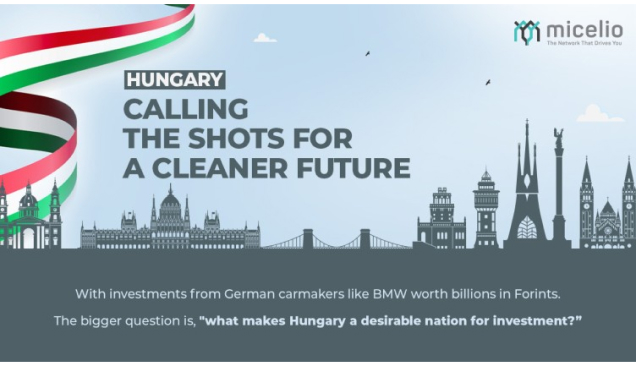
Synopsis: Automotive industry is one of Hungary’s most important businesses, employing over 170,000 people and accounting for around 20% of overall exports. Electronics, IT, pharmaceuticals, and medical technology, as well as renewable energy, are becoming increasingly essential as the government shifts its attention to R&D and innovation. What to look out for is how Hungary’s government encourages international investment in clean mobility.
The transition towards sustainable and smart mobility has become an emerging pattern in Hungary in recent years. The Hungarian government has adopted the National Energy and Climate Strategy in 2020 focusing on the transition to a carbon-neutral economy. One of the priorities of this strategy is the greening of the transport sector. In 2019, the law on electromobility was adopted which encourages the use of e-cars and e-vans and the necessary ev charging equipment and associated infrastructure. Due to many government incentives, Hungary continues to build a unique standing in the sector, among others in the area of battery production.
As the government of Hungary has taken prominent steps towards smart mobility, leading industry leaders like BMW, Mercedes, and Volkswagen are rising to the occasion to mark their respective territories and establish their no-fossil fuel led factory units. The city of Debrecen in Eastern Hungary is fast catching up as the electric vehicle power hub with investments from German carmakers like BMW worth billions in forints. The larger question however is, “what makes Hungary an ideal country for investment”?
- Hungary: A manufacturing powerhouse
Due to its advantageous geographic location and highly skilled and educated labor force (roughly two-thirds of the workforce in Hungary have at least completed secondary, technical, or vocational education), Hungary is seen as an ideal hub for manufacturing companies, services of all kinds, as well as logistics-related activities, among others. This makes the country a perfect place to lay the foundation for a smart mobility ecosystem.
- One of the highest motorway densities in Europe
The country has one of the highest motorway densities in Europe (after Belgium and the Netherlands); main European cities can be reached from Budapest within a couple of hours drive. Furthermore, Hungary is crossed by three Pan-European Transport Corridors (TEN-T). Although landlocked, Hungary has a direct connection to all significant harbors and terminals in Europe. Several main train lines connect Hungary with the main ports of Western Europe (e.g. Hamburg, Bremerhaven, Rotterdam) as well as the Adriatic (Koper, Rijeka, Trieste) and the Mediterranean (Piraeus) with regular block train services. Furthermore, Hungary has access to the North Sea and the Black Sea via the river Danube. The Danube-Rhine-Main Canal connects Rotterdam, Amsterdam, Antwerp, and the industrial centers of Western Europe with the Black Sea, through the Danube–Black Sea Canal with Constanta. Hungary is within two hours by air from most major European capitals, and provides a key link between Europe and the markets of the East.
- Key Government Initiatives and Policies enabling and facilitating adoption
The policy initiatives of the Hungarian Government are directed at increasing the EV adoption in the country. Individuals and companies find it beneficial to buy EVs due to the tax allowances given by the Government. Electric Vehicles are exempted from registration tax, vehicle tax, company car tax, and the purchase of EVs is also exempted from duty on onerous transfer of property. They also have added benefits of having a green number plate thus making it cumulatively a better choice than ICE engine vehicles.
- On its way to Carbon Neutrality 2050
Hungary is on its way to back the e-mobility vehicle services sector by powering it with clean and sustainable energy sources and is committed to being carbon neutral by the year 2050. Hungary’s National Energy and Climate Plan along with its National Energy Strategy aims to produce 90% of the domestic electricity from carbon-neutral sources and slowly phasing out coal. The country is aiming to replace natural gas with hydrogen as the source of energy in the Final Energy Consumption in fuel especially in the industrial and transport sectors thus making it truly sustainable (IEA, 2022).
- The Transport Greening Program
The program aims to reduce the growth rate of the sector’s GHG emissions by encouraging the spread of electric vehicles and car sharing, as well as increasing the use of biofuels. Another goal is to promote the domestic production of electric vehicles and to support domestic research related to the secondary use of used electric car batteries. Priority support is proposed for the use of second-generation biofuels; the related pilot project would serve in the testing of such fuel production technologies.
Given Hungary’s recent rise to prominence as a key player in Central Europe’s mobility ecosystem, companies could explore Hungary for its Europe market entry. One of the reasons why companies should think about investing in Hungary is the strong government backing. This covers funding for R&D, spending on the infrastructure needed for charging, and tax advantages for EV producers. Hungary’s competitive manufacturing costs, which include a well-developed manufacturing sector and reasonably low labor costs, are another key cost-cutting factor. This makes Hungary an interesting site for EV makers looking to reduce overhead costs and expand their market across Central Europe.
References
IEA (2022) Hungary 2022: Energy Policy Review. International Energy Agency. Available at: https://iea.blob.core.windows.net/assets/9f137e48-13e4-4aab-b13a-dcc90adf7e38/Hungary2022.pdf.
Deloitte. (2021). Smart and sustainable mobility market in Hungary. Netherlands Enterprise Agency. Retrieved from https://www.rvo.nl/sites/default/files/2021/04/Smart-sustainable-mobility-market-Hungary.pdf
FLANDERS INVESTMENT & TRADE MARKET SURVEY . (2019). Logistics Sector in Hungary. FLANDERS INVESTMENT & TRADE. Retrieved from https://www.flandersinvestmentandtrade.com/export/sites/trade/files/market_studies/2019-Hungary_Logistics.pdf?


